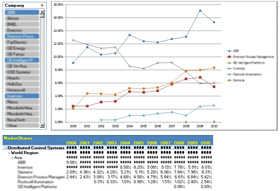Direct-to-consumer (e-commerce/omni-channel) fulfillment requirements remain the greatest factor contributing to the growth of the global Warehouse Management Systems (WMS) market. Furthermore, the need for expedited delivery has encouraged companies to adjust fulfillment capabilities or even relocate facilities closer to consumers, further contributing to demand for WMS functional enhancements or expanded licensing. Labor productivity is an ongoing objective for the implementation and use of WMS. However, labor constraints have become more severe over the last couple years. As COVID-19 recedes, economies continue to operate with a shortage of reliable warehouse labor in an inflationary environment. Labor reliability and cost are now of heightened importance, and warehouse operators are turning to WMS and WMS labor management/resource management solutions to assist with labor productivity, employee engagement, and the identification of more creative ways to increase warehouse performance. Many companies are turning to automation and robotics to help expand warehouse productivity. Warehouse management systems providers that support automation integration and orchestration are benefiting from the ability to manage both warehouse labor and automation capabilities in concert.
"Warehouse operators are increasingly challenged with fulfilling orders in short time with limited resources, in a cost-effective manner. The importance of fulfillment in e-commerce, coupled with labor constraints and elevated inflation, are rendering the warehouse performance improvements enabled by WMS a “must have” for thriving in this challenging economic environment," according to Clint Reiser, Supply Chain Research Director and key author of ARC's Warehouse Management Systems Market Research Report.
Warehouse Management Systems Market Trends
In addition to providing detailed competitive market share data, the report also addresses key market trends as follows:
- E-Commerce Fulfillment
- Global Economy
- Retail Industry
- Software-as-a-Service (SaaS)
- Warehouse Automation
Leading Suppliers to the Warehouse Management Systems Market Identified
In addition to providing specific market data and industry trends, this ARC market research also identifies and positions the leading suppliers to this market and provides and summarizes their relevant offerings. An alphabetical list of key suppliers covered in this analysis includes: Blue Yonder, Körber Supply Chain, Manhattan Associates, Oracle, SAP.
About the Warehouse Management Systems Research
 The Warehouse Management Systems report explores the current and future market performance and related technology and business trends and identifies leading technology suppliers. This new research is based on ARC’s industry-leading market research database, extensive primary and secondary research, and proprietary economic modelling techniques. The research includes competitive analysis, plus five-year market forecasts and up to 5 years of historical analysis segmented by Revenue Category, World Region, Industry, Customer Tier, Type, Retail by Vertical, Add-on by Type.
The Warehouse Management Systems report explores the current and future market performance and related technology and business trends and identifies leading technology suppliers. This new research is based on ARC’s industry-leading market research database, extensive primary and secondary research, and proprietary economic modelling techniques. The research includes competitive analysis, plus five-year market forecasts and up to 5 years of historical analysis segmented by Revenue Category, World Region, Industry, Customer Tier, Type, Retail by Vertical, Add-on by Type.
This new research is available in a variety of formats to meet the specific research and budgetary requirements of a wide variety of organizations. These include:
- Market Intelligence Workbook (Excel Power Pivot): A standard Workbook includes the base year market data and a five-year market forecast. This workbook enables licensed users to freely manipulate the data to make it easier to analyze the latest data for business intelligence and generate custom reports. Available with up to 5 years of historical analysis.
- Concise Market Analysis Report (PDF): This wide-screen presentation format makes it much easier to find detailed information on a market. This new format provides executives, business unit managers, and other authorized users with immediate access to in-depth market analysis, including analysis associated with every market data chart and figure. Included is an executive-level summary of the current market dynamics, five-year market forecast, and competitive analysis, plus an overview of strategic issues. The PDF is available with a comprehensive set of charts with associated analysis.
For more information on this and other available ARC market research, please visit our Market Data & Studies section.
